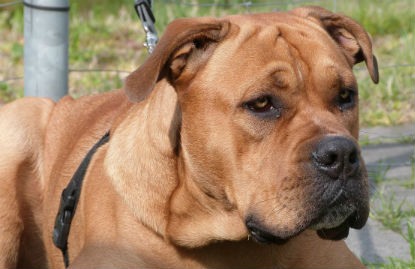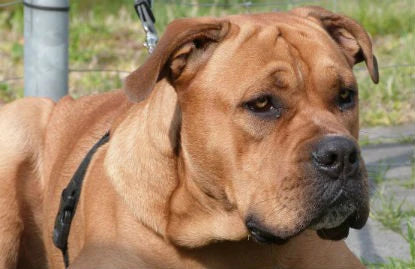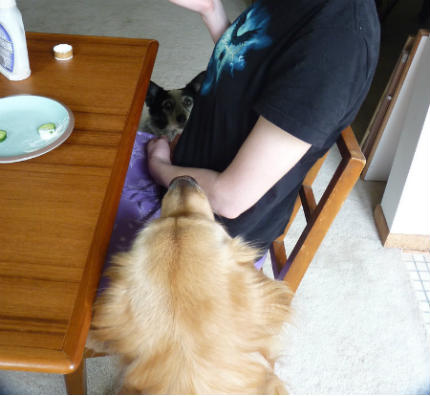With a brave, strong and muscular appearance, this is how the Ca de Bou dogs are recognized in society, also known as the Majorcan Dogo or Majorcan Presa Dog. These highly courageous canines have a very interesting history.
- Medium size .
- Weight : Between 30 and 38kg.
- Hair type : Short and dense.
- Character : Balanced, strong and brave breed.
- Health : Healthy but likely to suffer from common diseases in molosser dogs
- Life expectancy : 12 years average life.
Originally from the Balearic Islands, this breed did not have a very successful beginning, as its recognition came from its participation in fights between bulls and this breed. That's where the name Ca de Bou comes from, which in Catalan means " bull dog ", because of these confrontations.

However, with the passage of time this changed and the Majorcan Dogo went from being a fighting animal to becoming an excellent guardian , affectionate and above all loyal to its family environment, as it is known until now.
It is also an athletic and intelligent dog. But it is important to know much more about these canines before welcoming them into our home. Needs, health, behavior and origin are some of the most prominent topics.
That is why on this occasion, we will dedicate this article to studying everything related to the Ca de Bou breed, since keeping yourself informed about it will make you become a responsible owner, who knows how to care for this beautiful specimen.
Origin of the breed
The descent of this breed dates back to approximately the year 1232, the time in which the conquest of the Balearic Islands by King James I took place . Their arrival in this territory accompanied by Molosser and Alan dogs from the Iberian Peninsula is the key reference point for their origin.
Years later, the islands became part of English lands, as a result of the Treaty of Utrecht, a fact that was not very positive for these canines. The English, at that time, used animal fights as entertainment. The confrontation between bulls and dogs was one of the most popular "sports", which is where these canines began to be used for this purpose.
The need to look for a powerful, brave animal with enough strength to prevail against the bull and also capable of withstanding the temperature of the islands gave rise to different crosses. Different molossers , including the Bulldog, were used in this process until reaching the Mallorcan Presa Dog.
His name is translated as " bull dog " in Catalan, attributed mainly to his beginnings in fights. And, furthermore, because it is an animal used by butchers to kill cattle and control their livestock.
The return of the islands to Spanish territory put an end to what would be the bull and dog fights. The Ca de Bou breed then began to be seen in a different way, standing out as an excellent guard dog and butcher's assistant.
The Majorcan Dogo, as it is known today, is an imposing dog but very loyal to its owners , which is why it has not hesitated to consider itself a pleasant option if you are looking for a protective and balanced companion.
However, they require great socialization at an early age, otherwise they can become an aggressive animal.
Physical characteristics of the Majorcan Dogo
When we look at a dog of the Ca de Bou breed, we can notice its robust, muscular and strong build. This is what mainly characterizes the specimens of this species.
We are talking about an animal of medium height with a thick and heavy body, longer than wide, deep chest and obviously well formed. Let's see more details regarding his physical appearance below:
Weight and height
According to data from the International Cynological Federation, whose officialization of the breed was made in 1996, the weight of this breed remains at 35 to 38 kilograms for males and in the case of females, from 30 to 34.
The standard also highlights height according to sex, males stand out for measuring between 55 and 58 centimeters, and females from 52 to 55 cm.
head and face
The head of this breed is proportional to its body, that is, large, robust and generally square in shape. Its skull is large, as is the front or top of its face, which is quite notable.

It has an intimidating look, emphasized by its large, oval-shaped eyes that are usually dark in color. Its nose is medium-sized, black, and its snout is wide, with large teeth, which shows a fairly strong bite.
The ears, for their part, are set very high, but located well apart on the sides of the head. They are small, triangular and appear to be placed backwards.
Line
The Majorcan Dogo has a thick but profiled tail from the beginning to the tip. Commonly, low insertion.
Fur
Brindle, fawn or black in color. This breed has a dense coat, although very short and dense. In some specimens white spots are allowed on the chest and legs. While in others it is common to find the black spot that covers the face and gives it that even more dominant and intimidating appearance for many.
Character and behavior
As a good guard dog, and also honoring its past, this breed is very balanced , strong, brave and above all determined. That is, he will not hesitate to attack anyone he considers to be a danger to him or his family.
However, for this reason it should not be characterized as a dangerous animal. The Majorcan Dogo, when well socialized, can become an ideal company for outdoor activities .

We are also talking about a reserved animal, that is, one that will not bark excessively if it is not considered necessary. But he will remain alert to any activity he sees suspicious and will protect his usual environment above all.
They get along well with their family environment, but they do not usually show frequent signs of affection. In fact, they are very independent and not very affectionate, so a lot of “pampering” by their owners can cause some discomfort.
On the other hand, these animals are quite athletic. In other words, they require frequent exercise to stay fit and emotionally stable.
Living with them
Living with these dogs is not such an easy issue to handle, since we are talking about an animal that is distrustful by nature, difficult to adapt to the presence of strangers in a simple way. On the contrary, he will appear intimidating to these people.
The same thing happens with other animals, it can even attack other dogs if it feels that they are invading its space.

In relation to the family, these dogs are loyal , patient and above all protective. In the case of homes with children, it is necessary to maintain vigilance to avoid unexpected incidents.
Its behavior both at home and with other people and animals will largely depend on the socialization provided to the dog. An adequate education will define the bases for this strong friend to behave appropriately and remain even more balanced.
Training the Mallorcan Presa Dog
The education of a Ca de Bou is imperative from the first weeks of these canines' lives . Constant and persistent, although very patient, must be the training that this breed receives. Well, due to their nature, they require more socialization than some other breeds .
It is essential to start training as soon as possible and do so with socialization first. These animals require learning to behave in the family environment and coexistence with other animals, so that it is easy to make them part of any home.
Although it is not a truly obedient dog in the first instance due to its independence and drive, these animals can receive orders, as long as they are given in a good way.

Like many breeds, they do not respond to shouting or mistreatment, so positive reinforcement should be considered from the beginning as a more suitable measure of training.
It will be difficult for them to learn basic commands quickly, but consistency and patience will be decisive for the training of these animals.
It is important that the person in charge of training has control and knowledge about the breed. In this way, you will know how to carry out the training properly and you will obtain positive results for the canine and your family.
Health of Ca de Bou
Particularly, there are no diseases associated with these dogs. This could translate into a very healthy breed, with a life expectancy that averages 12 years and even a little more.
However, there are some common pathologies in molosser dogs which, due to their physical build, can also affect these dogs. These are:
- elbow dysplasia
- Hip dysplasia
- ectropion
- Entropion
- Respiratory and cardiac deficiencies
It is worth noting that some of these diseases can be hereditary. However, according to the care and attention provided to this breed, an optimal state of health can be maintained.
Care you need
The Ca de Bou is a breed that does not demand special or forced care from its owners. Just pay attention to a few details and it will be enough to keep this canine calm and healthy.
First of all, we must consider that it is not a dog that requires rigorous brushing. He has a very short coat, so two brushings a week will be enough for him. Like the bathroom, whose frequency should be monthly (if you live in an apartment or apartment) or when it is really dirty. Otherwise it is not necessary.

On the other hand, the issue of exercise and nutrition is, ultimately, one of the most important. These dogs are quite athletic, which means that they require at least three walks a day, accompanied with physical activity, to stay in shape and also emotionally calm.
As for food, it must be complemented with exercise to avoid obesity in the canine, providing adequate nutrients through feed and taking care not to overindulge in food and treats will help the dog maintain its ideal weight.
They are not ideal pets for small spaces. These animals require a considerable amount of land to play, run and maintain. If confined in too small a place, it can become destructive.
Finally, although it is a robust dog, the care and control of vaccines, deworming and visits to the veterinarian are essential to maintain its adequate state of health.
Conclusion
The Ca de Bou is a special pet. In other words, it cannot be for everyone. Although it does not require much care to maintain, its owner must have knowledge of the breed, in this way he will be able to control it and act appropriately if the dog becomes aggressive.

Let us remember that, although it is not a potentially dangerous animal, the nature of these canines has forged a special character in it that needs to be socialized so that it acts in a balanced way.
For everything else, we are faced with a loyal, protective and permanently vigilant race, intimidating due to its physical appearance, but with a noble heart towards its direct environment.
He will protect his people from any unforeseen event, since bravery is part of his natural character , and he will undoubtedly attack if he perceives danger or risk.
It is a dog that requires a lot of physical activity, which is why small places are not suitable for its coexistence. And, although it does not require much care, keeping it in shape and well fed should be the most important thing for these animals.
Consider each aspect read before deciding if the Majorcan Dogo is the ideal companion for your home.
Learn more dog breeds here :












